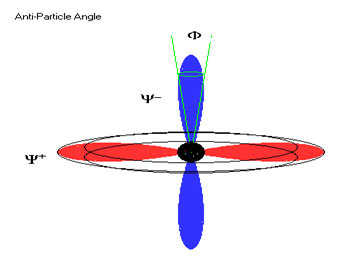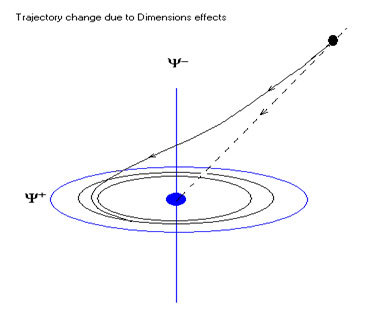Effect of Dims
As mentioned before, Dims have a huge effect on
Omegas (Creation Process) and would make any Omega to Complete its group by
creation of other complementary Omegas (Other 15) no matter the influenced
Omegas form a complete set , even in a sub particles and materials.
So any radiating field of Dims
would have the same effect on the surrounding space as the beginning, on Omegas which are under their influence.


The composed Dims in
Black Holes (When they reach to a certain level of intensity) then would
propagate through space as a radiating cone, very narrow at the beginning, but
cone opens as the intensity of the field increases that happens as mass of that object grows. At some specific Black
Hole mass or specific field strength would change to sphere.
The
observed shinning cone of any Black Hole is the mentioned field, and its result
(between Dims and TAs, Sub particles, Materials) would burn the Black
Hole surrounding space to the composed Omegas (indeed nothing could resist in
the surface of Dims field except Omegas). The Black Hole Dim fields are called (ψ-)(cone),
also the gravitational force between materials and Black Holes are called (ψ+)(plate).
In all materials, Dims would be reconstructed again. At stars these Dims are sensible. Dims in massive stars would have dominant forces of (ψ-) and (ψ+). The ψ+ has attracting force to materials (Love materials) and ψ- has repelling force to materials (Hate materials).
Direction of ψ- passes through the star (as a rod / cone /sphere) and prevents any other materials to approach to the star (scatters any combination of Omegas to pure Omegas). But ψ+ passes through star as a disk perpendicular to ψ- and is attracting all materials to the star.
The ψ- is opposing to anything carrying ELECTUS so pushes them to go away, and ψ+ attracts material (Electuses) via center disk, therefore a magnetic field (from north to south) and electric field (outward) would be created and these fields control the path of approaching materials to the star. The ψ- direction works as spindle of star and star rotates around it. Ψ- is called Anti-particle field and its intensity and half-power angle are proportional to mass of star. Ψ+ is called Attracting-particle field and its intensity is proportional to mass of star and its Half-power angle is inversely proportional to mass of star.

Fig. 25- Angle of anti-particle
All stars have ψ+ and ψ- and mass of that star determines intensity of these fields and in Black Holes their effects are dominant. These fields are created in the solar systems and force the planets to move around sun in a disk. Strength of force depends on the mass of sun, mass of planet and also distance of them to the sun. In some Black Holes these fields are so strong that dish is very tiny and rod becomes a double cone shape. The rods or cones have effect on the Omegas at their vicinity and will produce new Omegas. These Omegas consequently are changed to Tempeta and this process makes the rod or cone shining. If the Black Hole is very massive then the whole surface (except a tiny path of disk) will be shining.
To travel outside a solar system, it is better to move perpendicular to its disk or plate.

Fig. 26- Trajectory change of approaching objects
It is important for Galaxies or Black Holes to align then axis when they are approaching each other.